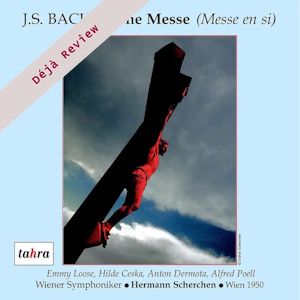
Déjà Review: this review was first published in February 2007 and the recording is still available.
Johann Sebastian Bach (1685-1750)
Mass in B minor, BWV232
Emmy Loose (soprano); Hilde Ceska (soprano); Gertrud Burgsthaler-Schuster (contralto); Anton Dermota (tenor); Alfred Poell (bass); Anton Heiller (organ)
Vienna Academy Chamber Choir
Vienna Symphony Orchestra/Hermann Scherchen
rec. October 1950, Mozartsaal, Vienna
Tahra TAH618/19 [2 CDs: 123]
Scherchen left two commercial recordings of the B minor Mass, both in the 1950s, and both taped in Vienna. The performances are entirely consonant with Scherchen’s accepted imperatives – extremes of tempo foremost – and not at all dissimilar. I last saw the 1959 performance with Pierette Alarie, Nan Merriman, Leopold Simoneau and Gustav Neidlinger on Westminster 471253. Those who have heard the Westminster Mozart Requiem, recently licensed to, and released by, Tahra will know that the approach was as consistent in liturgical music as it was in symphonic. And such is very much the case here.
The most obvious stumbling point for current sensibilities occurs in the opening Kyrie. This is a distended and exceptionally slow performance, and one that immediately throws up a barrier. The chorus is a woolly one, highly – indeed singularly – operatic in impress, and sporting some sopranos who seem keen to make a bid for theatrical immortality. Blending is not a strong point nor is there a remotely consistent approach to tone where we find a big variety of vibratos on offer. The basses are better whilst the tenors are a touch weak. Once one accepts these features – if indeed one does – the path to following Scherchen becomes that much clearer.
Scherchen feasted on contrasts – contrasts of tempo and contrasts of dynamics. His two Kyries are therefore subjected to maximal Scherchian contrast by virtue of a defiant and uplifting Christe Eleison, by which the two Kyries are bisected. The two sopranos are good here and they make for a fruitful tonal contrast – Loose clear and tight, Ceska taking her part low and well. Scherchen piles on dynamic extremes and textual contrasts in the Gloria.
Dermota surprised me in this recording; he’s not very good. He sounds rather strangled in the duet Domine Deus and is convincingly outsung by Loose. He’s no competition for an artist like Simoneau in the later recording. I also fail to follow him in the Benedictus – who is the uncredited violinist? Willy Boskovsky invariably did the honours with the Vienna State/Philharmonic – where Dermota starts crooning like Al Bowlly. And the alto Gertrud Burgsthaler-Schuster dismally fails to convince in Qui sedes, which finds her wobbly, pitch deficient and halting going up, where her vocal colour sheds alarmingly. For some strange reason she recovers in the Agnus Dei where she was obviously more comfortable and she redeems herself. Poell proves a noble, straightforward but engaging presence; a non-cavernous bass of warmth in the Quoniam and Et in spiritum sanctum.
Elsewhere we find some excellent wind playing – flutes in particular – and some alert string playing in patches. If one finds the Crucifixus too slow then one might give Scherchen the benefit of expressive doubt in respect of the architectural wholeness he is trying to establish.
The notes are bilingual, French and English, and there is a reproduction of the beginning of the Credo in Scherchen’s score, with vigorous blue pencil markings and a host of other instructions. For him this was a living text; a source of drama and commitment.
Jonathan Woolf
Buying this recording via a link below generates revenue for MWI, which helps the site remain free



















